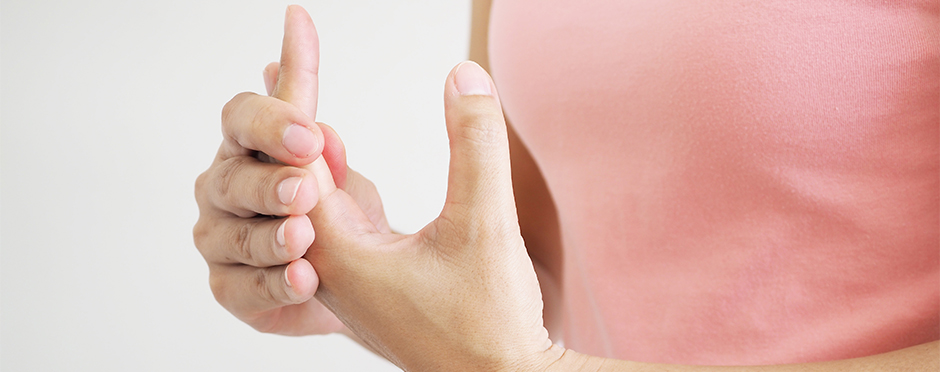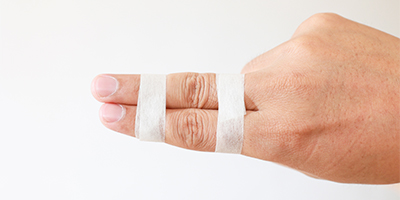
When to Seek Help for a Jammed Finger
Leave a CommentUnfortunately, jammed fingers are common on job sites, during contact sports, a fall, or when doing some weekend warrior activities while crossing heavy chores off the to-do list. But when is it more than just a jammed finger? When should you seek professional medical treatment?
Causes of a Jammed Finger
A jammed finger occurs when there is a direct force to the tip of a finger, compressing it toward the hand. The compression can stretch or “sprain” the ligaments supporting the middle joint of a finger, even to the point of tearing the ligaments partially or fully. A jammed finger can lead to pain, swelling, and the inability to bend or straighten the finger fully.1,3
If you incur a jammed finger, you should initially follow the first aide principles of RICE (rest, ice, and elevation) of the finger to decrease swelling. A light compressive wrap can decrease swelling but use caution to avoid pressure that is too tight as it could limit blood flow to the finger.3 Many jammed fingers can be treated conservatively with short-term immobilization or buddy strapping to the neighboring, uninjured finger. Buddy strapping supports the finger by not allowing sideways forces to the knuckle while it’s wrapped to an adjacent finger. It also allows for gentle movement as the finger next to it keeps it limber while it is moving.1

When to Seek Treatment for a Jammed Finger
- There is a prominent deformity, such as the finger not being straight or a portion of the finger looking elevated or lower than the same finger on the other hand.
- If the finger is unable to hold normal alignment and seems to fall in and out of place with movement.2,3
- If severe pain and significant swelling are present in hand and not just localized to the finger, this could be a sign of a fracture, and medical treatment should be provided.
Ultimately, if soreness persists after several days of conservative treatment, and there are no signs of improvement, such as decreased pain, decreased swelling and increased movement, seeking medical attention is recommended. If you are uncertain, it’s better to err on the side of caution and have the finger checked out.3
Treatment for a Jammed Finger
If it seems like your finger is more than “jammed,” an x-ray will likely be performed to check for a fracture or misalignment. The sooner one seeks care for a severe injury, the more likely they will have an optimal outcome, and the treatment may even be less invasive.
If there is a dislocation, a trained medical professional should reduce (or realign) the finger to avoid permanent joint damage.2,3 An x-ray can reveal information about the bones, such as fractures and dislocations. Still, other imaging, such as an MRI or CT, may be indicated to look for tendon, ligament, or other soft tissue injuries.1 If a fracture is observed on the x-ray, treatment may include immobilization to allow for healing of the fracture.1 In some cases, surgery may be indicated if the joint space is involved or an unstable fracture.
An Athletico Hand Therapist Can Help
Finger anatomy is very complex, and several types of injuries can lead to permanent stiffness and deformity if left untreated. Proper treatment will lead to less pain, disfigurement, and loss of motion, and decreased arthritis in the future.1,2,3 Your doctor or health care practitioner may recommend hand therapy after a finger jam or if surgical intervention is recommended. Proper treatment can be effective in decreasing edema and pain. A hand therapist will perform an evaluation to recommend exercises and activities to improve range of motion, optimize your overall outcome and shorten the duration of symptoms. They can also fabricate a custom orthosis to hold the finger in proper alignment to heal a fracture or soft tissue injury.1 Get started with a hand therapist near you today!
Find a Hand Therapist Near You
The Athletico blog is an educational resource written by Athletico employees. Athletico bloggers are licensed professionals who abide by the code of ethics outlined by their respective professional associations. The content published in blog posts represents the opinion of the individual author based on their expertise and experience. The content provided in this blog is for informational purposes only, does not constitute medical advice and should not be relied on for making personal health decisions.
References:
1. Bozentka, David J. “Ask a Doctor: Jammed Finger.” The Hand Society, 31 Mar. 2016, https://www.assh.org/handcare/blog/ask-a-doctor-jammed-finger.
2. “Jammed Finger: Symptoms and Treatment: The Hand Society.” Symptoms and Treatment | The Hand Society, 2015, https://www.assh.org/handcare/condition/jammed-finger.
3. Miller, Tom, and Nikolas Kamers. “Should I Worry about a Jammed Finger?” University of Utah Health, 24 Mar. 2021, https://healthcare.utah.edu/the-scope/shows.php?shows=0_2wuztwn9.
